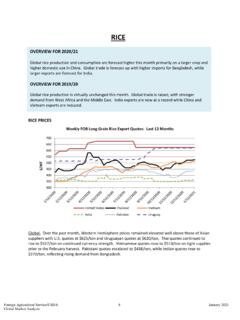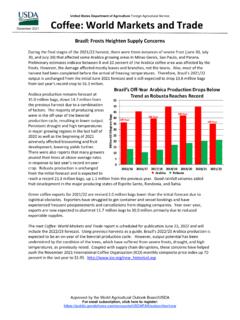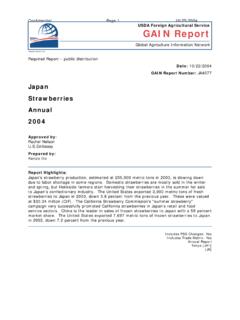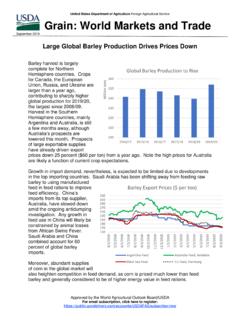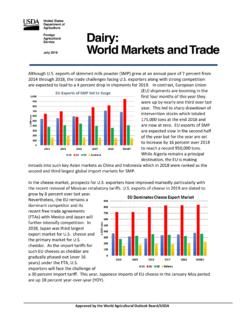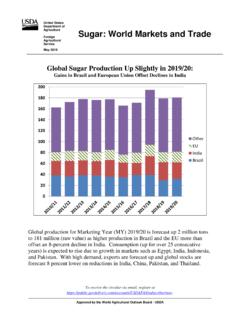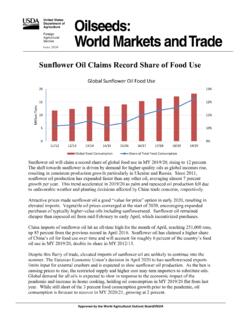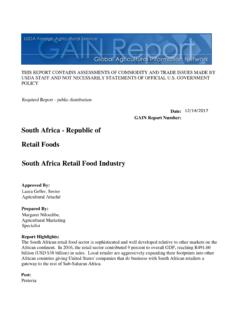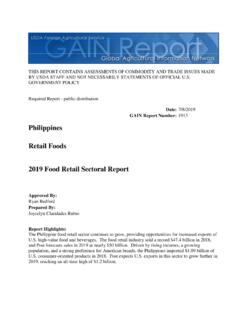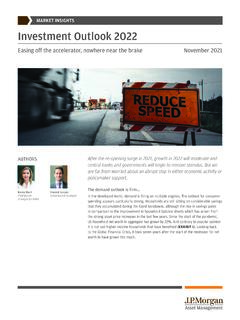Transcription of United States Agriculture World Agricultural Production
1 Approved by the World Agricultural Outlook Board United States Department of Agriculture Foreign Agricultural Service Circular Series WAP 2-22 February 2022 Brazil Soybeans: Drought Reduces Production Estimate Brazil soybean Production for marketing year 2021/22 is estimated at million metric tons (mmt), down mmt (4 percent) from last month, and lower by mmt (3 percent) from last season s record crop. Harvested area is estimated at a record million hectares (mha), up mha (4 percent) from last season s record area. Yield is estimated at tons per hectare (t/ha), 4 percent below last month and 7 percent lower than last season. The decline this month reflects the continuing poor vegetation status of crops and early harvest results in southern Brazil. Roughly 30 percent of Brazil s soybean area is cultivated in the two States of Paran and Rio Grande do Sul.
2 This region is experiencing a historic drought with below-average precipitation and anomalously high daytime temperatures. Similarly, southeastern Mato Grosso do Sul, where a large portion of the state s soybeans are grown, also received below-average rainfall. This situation resulted in high evaporative stress and coincided with the crop phenological stages most sensitive to moisture stress. The drought-stricken areas correspond to areas exhibiting a significant World Agricultural Production reduction in crop vegetation status, shown in the satellite-derived Percent of Average Seasonal Greenness (PASG) index. The state reporting agency for Paran , SEAB-DERAL (Secretaria de Estado da Agricultura e do Abastecimento Departamento de Economia Rural), and the Technical Assistance and Rural Extension of Rio Grande do Sul (EMATER-RS) report substantial yield losses. The return of rainfall in mid-January arrived too late for much of the crop, although it will benefit the later planted crop.
3 States in the center-west and northern regions received abundant rainfall and crop conditions were favorable during the growing season. Approximately 12 percent of the crop has been harvested nationally and about 32 percent in the largest producer Mato Grosso, well ahead of the 5-year pace of 17 percent for the state. (For more information, please contact Foreign Agricultural Service/USDA 2 February 2022 Global Market Analysis Paraguay Soybeans: Historically Dry Conditions Limit Yields USDA estimates Paraguay soybean Production for marketing year (MY) 2021/22 at million metric tons, down 26 percent from last month and 36 percent from last year. Area is set at million hectares, down 13 percent from last month and 11 percent from last year.)
4 Yield is estimated at tons per hectare, down 15 percent from last month and 28 percent from last year. Foreign Agricultural Service/USDA 3 February 2022 Global Market Analysis Soybean Production expectations continue to decrease after farmers reported dry field conditions and almost no rain. Widespread areas of eastern Paraguay reported persistent dry conditions throughout the growing season, including the top-producing department Alto Paran . For example, the department of Canindey did not have sufficient rain from September 30 through December. Much needed rain arrived in late January 2022. Soil moisture conditions across soybean regions have been suboptimal for crop growth and pod filling. High protein levels and very small beans are expected from this harvest. Combining has begun, but early reported yields are poor and below even past, historically low average yields in MY 2008/09 and MY 2011/12.
5 (For more information, please contact India Rapeseed: Production up 27 Percent from Last Year USDA forecasts India rapeseed Production for marketing year (MY) 2021/22 at million tons, up 14 percent from last month and 27 percent from last year. Area is estimated at million hectares, up 2 percent from last month and up nearly 27 percent from 2020 due to favorable planting conditions and a 9 percent higher minimum support price from 2020. Yield is forecast at metric tons per hectare, up 11 percent from last month and up slightly from last year. Foreign Agricultural Service/USDA 4 February 2022 Global Market Analysis According to the India Ministry of Agriculture s All India Crop Situation report published January 27, 2022, farmers have planted million hectares of rapeseed/mustard, up 25 percent from the same period last year.)
6 In Rajasthan, the largest producer, planting is up nearly 37 percent from the same period last year. Currently, the rapeseed crop is flowering. The satellite-derived Normalized Difference Vegetation Index (NDVI) anomaly (January 24 - February 1, 2022) shows strong crop vigor in Rajasthan. Trade reports have not indicated any incidences of pests or disease. Rapeseed is grown only in the rabi season. Rapeseed is planted in early November until January and harvested in late March. (For more information, please contact Brazil Corn: Production Lowered Due to Reduced Yields for the First Crop Brazil total corn Production for marketing year 2021/22 is estimated at a record million metric tons (mmt), lower by mmt (1 percent) from last month, but larger than last year s crop by mmt (31 percent). Total harvested area, for all three corn crops, is estimated at a record million hectares (mha), up mha (5 percent) from last year. Yield is estimated at tons per hectare (t/ha), about 1 percent lower than last month, but 25 percent above last year s dismal crop, and 5 percent above the 5-year average.)
7 This month s reduction reflects the yield losses for the first crop in the southern States of Paran , Rio Grande do Sul, and Santa Catarina. Foreign Agricultural Service/USDA 5 February 2022 Global Market Analysis Drought conditions persisted through mid-January for the largest first-crop producing region of southern Brazil. Low rainfall amounts combined with high maximum temperatures resulted in high evaporative stress for crops, shown by the seasonal Evaporative Stress Index (ESI). Further evidence is provided by the satellite-derived Normalized Difference Vegetation Index (NDVI) that indicates low vegetation vigor throughout the south (roughly 36 percent of total first-crop area). Brazil s Agriculture Ministry, Companhia Nacional de Abastecimento (CONAB), reduced first-crop yield by 15 percent from their prior month estimate.
8 Production in Paran , Rio Grande do Sul, and Santa Catarina were reduced by 35, 48 and 3 percent, respectively. Although CONAB reduced estimates in Santa Catarina by 3 percent, according to state-level organizations, Santa Catarina yield losses are over 40 percent. Weather was more favorable in the northeastern regions. Harvest is underway in the southern regions with 11 percent harvested overall. Foreign Agricultural Service/USDA 6 February 2022 Global Market Analysis Planting of the larger second-season crop, roughly 75 percent of total Production , follows the soybean harvest. With a timely soybean season this year, the expectation is for a timely safrinha planting in contrast to the delayed planting and dismal crop last year. Farmers are anxious to plant the safrinha crop on time as this improves the likelihood of a normal yield outcome, specifically in Mato Grosso where the rainy season typically ends in mid to late April.
9 Currently, planting stands at 15 percent nationally with the state of Mato Grosso (45 percent of second-crop Production ) setting a brisk pace in January, 12 percent ahead of the 5-year average. Weather conditions are favorable for planting in the center-west and the south, where rains returned mid-January in Paran (15 percent of safrinha Production ). (For more information, please contact Foreign Agricultural Service/USDA 7 February 2022 Global Market Analysis Philippines Corn: Record Quarter Four Output Increases Estimated Production USDA estimates Philippines corn Production for marketing year (MY) 2021/22 at million metric tons, up 4 percent from last month, but down 3 percent from last year. Harvested area is estimated at million hectares, up 4 percent from last month and 1 percent from last year.)
10 Yield is estimated at tons per hectare, unchanged from last month, but down 4 percent from last year. Philippines reports corn output on a quarterly basis. The USDA marketing year begins with quarter three, July through September, and represents the largest quarterly output. The MY 2021/22 corn campaign began with uncertainty after quarter three output and area was reported by the Philippine Statistical Authority (PSA) at 19 percent and 12 percent lower than last year, respectively. The declines in quarter three were primarily due to farmers shifting to more profitable crops and the lack of widespread adoption of quality seed. Conversely, quarter four corn output resulted in higher-than-expected estimates. PSA quarter four corn output and area were 29 percent and 18 percent above last year, respectively. According to the Philippines Department of Agriculture , record corn output in quarter four was achieved due to government support and extension services, which enhanced farm management practices.

